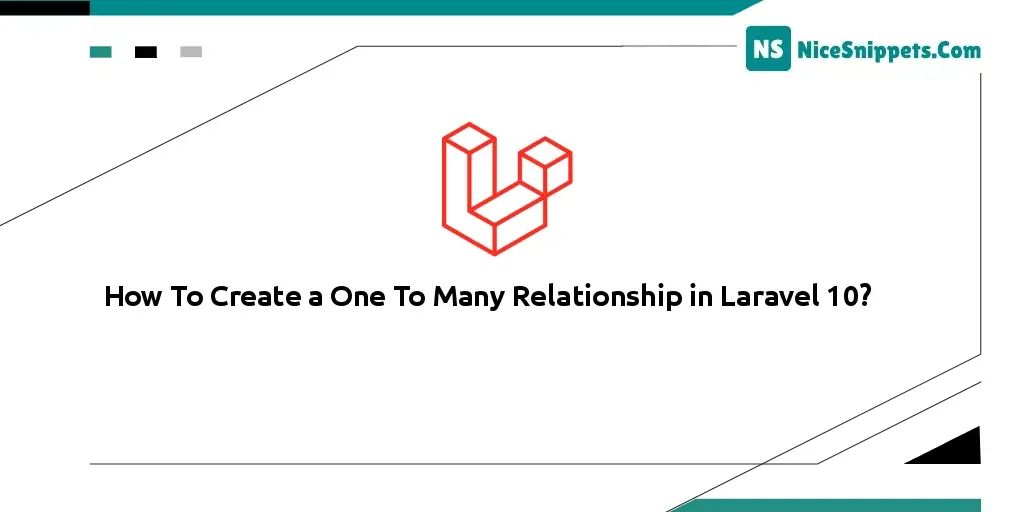20-Apr-2023
.
Admin

Hi friends,
Today I explain how to create a one-to-many relationship in Laravel 10. so now in this tutorial, I will show you Laravel 10 one to many eloquent relationships. When one table refers to many rows in another table that is called a one-to-many relationship. A one-to-many relationship is a very basic type of database relationship in Laravel 10.
Using one-to-many relationships, you can perform crud (create, read, update, delete) operations with the eloquent model from the database table in Laravel 10.
So let's start following example:
Step 1: Download Laravel
Let us begin the tutorial by installing a new Laravel application. if you have already created the project, then skip the following step.
composer create-project laravel/laravel example-app
Step 2: Add Migrations
Now we have to create a migration of the "posts" and "comments" tables. we will also add a foreign key to the posts table. so let's create like as below:
php artisan make:migration create_posts_table
database\migrations\2014_10_12_000000_create_posts_table
<?php
use Illuminate\Database\Migrations\Migration;
use Illuminate\Database\Schema\Blueprint;
use Illuminate\Support\Facades\Schema;
return new class extends Migration
{
/**
* Run the migrations.
*
* @return void
*/
public function up()
{
Schema::create('posts', function (Blueprint $table) {
$table->id();
$table->string("name");
$table->timestamps();
});
}
/**
* Reverse the migrations.
*
* @return void
*/
public function down()
{
Schema::dropIfExists('posts');
}
};
comments table migration:
php artisan make:migration create_comments_table
database\migrations\2014_10_12_000000_create_comments_table
<?php
use Illuminate\Database\Migrations\Migration;
use Illuminate\Database\Schema\Blueprint;
use Illuminate\Support\Facades\Schema;
return new class extends Migration
{
/**
* Run the migrations.
*
* @return void
*/
public function up()
{
Schema::create('comments', function (Blueprint $table) {
$table->id();
$table->foreignId('post_id')->constrained('posts');
$table->string("comment");
$table->timestamps();
});
}
/**
* Reverse the migrations.
*
* @return void
*/
public function down()
{
Schema::dropIfExists('comments');
}
};
Step 3: Add Models
Here, we will create Post and Comment table model. we will also use "hasMany()" and "belongsTo()" for relationship of both model.
php artisan make:model Post
app/Models/Post.php
<?php
namespace App\Models;
use Illuminate\Database\Eloquent\Factories\HasFactory;
use Illuminate\Database\Eloquent\Model;
class Post extends Model
{
use HasFactory;
/**
* Get the comments for the blog post.
*
* Syntax: return $this->hasMany(Comment::class, 'foreign_key', 'local_key');
*
* Example: return $this->hasMany(Comment::class, 'post_id', 'id');
*
*/
public function comments()
{
return $this->hasMany(Comment::class);
}
}
Comment Model:
php artisan make:model Comment
app/Models/Comment.php
<?php
namespace App\Models;
use Illuminate\Database\Eloquent\Factories\HasFactory;
use Illuminate\Database\Eloquent\Model;
class Comment extends Model
{
use HasFactory;
/**
* Get the post that owns the comment.
*
* Syntax: return $this->belongsTo(Post::class, 'foreign_key', 'owner_key');
*
* Example: return $this->belongsTo(Post::class, 'post_id', 'id');
*
*/
public function post()
{
return $this->belongsTo(Post::class);
}
}
Step 4: Retrieve Records:
php artisan make:controller PostController
app/Http/Controllers/PostController.php
<?php
namespace App\Http\Controllers;
use Illuminate\Http\Request;
use App\Models\Post;
class PostController extends Controller
{
/**
* Write code on Method
*
* @return response()
*/
public function index(Request $request)
{
$comments = Post::find(1)->comments;
dd($comments);
}
}
app/Http/Controllers/PostController.php
<?php
namespace App\Http\Controllers;
use Illuminate\Http\Request;
use App\Models\Comment;
class PostController extends Controller
{
/**
* Write code on Method
*
* @return response()
*/
public function index(Request $request)
{
$post = Comment::find(1)->post;
dd($post);
}
}
Step 5: Add Records:
app/Http/Controllers/PostController.php
<?php
namespace App\Http\Controllers;
use Illuminate\Http\Request;
use App\Models\Post;
use App\Models\Comment;
class PostController extends Controller
{
/**
* Write code on Method
*
* @return response()
*/
public function index(Request $request)
{
$post = Post::find(1);
$comment = new Comment;
$comment->comment = "Hi ItSolutionStuff.com";
$post = $post->comments()->save($comment);
}
}
app/Http/Controllers/PostController.php
<?php
namespace App\Http\Controllers;
use Illuminate\Http\Request;
use App\Models\Post;
use App\Models\Comment;
class PostController extends Controller
{
/**
* Write code on Method
*
* @return response()
*/
public function index(Request $request)
{
$post = Post::find(1);
$comment1 = new Comment;
$comment1->comment = "Hi ItSolutionStuff.com Comment 1";
$comment2 = new Comment;
$comment2->comment = "Hi ItSolutionStuff.com Comment 2";
$post = $post->comments()->saveMany([$comment1, $comment2]);
}
}
app/Http/Controllers/PostController.php
<?php
namespace App\Http\Controllers;
use Illuminate\Http\Request;
use App\Models\Post;
use App\Models\Comment;
class PostController extends Controller
{
/**
* Write code on Method
*
* @return response()
*/
public function index(Request $request)
{
$comment = Comment::find(1);
$post = Post::find(2);
$comment->post()->associate($post)->save();
}
}
I hope it will help you..
#Laravel 10